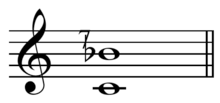Harmonic seventh
| Inverse | Septimal major second |
|---|---|
| Name | |
| Other names | Septimal minor seventh, Subminor seventh |
| Abbreviation | m7 |
| Size | |
| Semitones | ~9.7 |
| Interval class | ~2.3 |
| Just interval | 7:4[1] |
| Cents | |
| Equal temperament | 1000 |
| 24 equal temperament | 950 |
| Just intonation | 968.826 |


The harmonic seventh interval ![]() play , also known as the septimal minor seventh,[2][3] or subminor seventh,[4][5][6] is one with an exact 7:4 ratio[7] (about 969 cents).[8] This is somewhat narrower than and is, "particularly sweet,"[9] "sweeter in quality" than an "ordinary"[10] minor seventh, which has a just-intonation ratio of 9:5[11] (1017.596 cents), or an equal-temperament ratio of 1000 cents (25/6:1). The harmonic seventh may be derived from the harmonic series as the interval between the seventh harmonic and the fourth harmonic (octave of the fundamental).
play , also known as the septimal minor seventh,[2][3] or subminor seventh,[4][5][6] is one with an exact 7:4 ratio[7] (about 969 cents).[8] This is somewhat narrower than and is, "particularly sweet,"[9] "sweeter in quality" than an "ordinary"[10] minor seventh, which has a just-intonation ratio of 9:5[11] (1017.596 cents), or an equal-temperament ratio of 1000 cents (25/6:1). The harmonic seventh may be derived from the harmonic series as the interval between the seventh harmonic and the fourth harmonic (octave of the fundamental).
This note is often corrected to 16:9 (B♭-, 996.09 cents) on the natural horn in just intonation or Pythagorean tunings, but the pure seventh harmonic was used in pieces including Britten's Serenade for tenor, horn and strings.[12]

Composer Ben Johnston uses a small "7" as an accidental to indicate a note is lowered 49 cents (1018-969=49), or an upside-down "7" to indicate a note is raised 49 cents. Thus, in C major, "the seventh partial," or harmonic seventh, is notated as ♭ B with "7" written above the flat.[13][14]
Some theorists believe that the harmonic seventh is also used by barbershop quartet singers when they tune dominant seventh chords (harmonic seventh chord), and is an essential aspect of the barbershop style; however this claim was not supported by the empirical data of Hagerman and Sundberg (1980), and the failure of other psychological studies on intonation to find evidence for the harmonic seventh casts doubt on its musical or psychological existence. Instead, Hagerman and Sundberg found that tuning of major and minor third intervals in barbershop lies between just (4:5, 5:6) and equal temperament.

The harmonic seventh differs from the augmented sixth by 224/225 (7.71 cents), or about one-third of a comma.[16] The harmonic seventh note is about one third of a semitone (≈ 31 cents) flatter than an equal tempered minor seventh. When this flatter seventh is used, the dominant seventh chord's "need to resolve" down a fifth is weak or non-existent. This chord is often used on the tonic (written as I7) and functions as a "fully resolved" final chord.[17]
The twenty-first harmonic (470.78 cents) is the harmonic seventh of the dominant, and would then arise in chains of secondary dominants (known as the Ragtime progression) in styles using harmonic sevenths, such as barbershop music.
Notes
- ↑ Haluska, Jan (2003). The Mathematical Theory of Tone Systems, p.xxiii. ISBN 0-8247-4714-3. Harmonic seventh.
- ↑ Gann, Kyle (1998). "Anatomy of an Octave", Just Intonation Explained.
- ↑ Partch, Harry (1979). Genesis of a Music, p.68. ISBN 0-306-80106-X.
- ↑ Hermann L. F Von Helmholtz (2007). On the Sensations of Tone, p.456. ISBN 1-60206-639-6.
- ↑ Royal Society (Great Britain) (1880, digitized Feb 26, 2008). Proceedings of the Royal Society of London, Volume 30, p.531. Harvard University.
- ↑ Society of Arts (Great Britain) (1877, digitized Nov 19, 2009). Journal of the Society of Arts, Volume 25, p.670. The Society.
- ↑ Andrew Horner, Lydia Ayres (2002). Cooking with Csound: Woodwind and Brass Recipes, p.131. ISBN 0-89579-507-8.
- ↑ Bosanquet, Robert Holford Macdowall (1876). An elementary treatise on musical intervals and temperament, pp. 41-42. Diapason Press; Houten, The Netherlands. ISBN 90-70907-12-7.
- ↑ Brabner, John H F. (1884). The National Encyclopædia, Vol. 13, p.135. London. [ISBN unspecified]
- ↑ "On Certain Novel Aspects of Harmony", p.119. Eustace J. Breakspeare. Proceedings of the Musical Association, 13th Sess., (1886 - 1887), pp. 113-131. Published by: Oxford University Press on behalf of the Royal Musical Association.
- ↑ "The Heritage of Greece in Music", p.89. Wilfrid Perrett. Proceedings of the Musical Association, 58th Sess., (1931 - 1932), pp. 85-103. Published by: Oxford University Press on behalf of the Royal Musical Association.
- ↑ Fauvel, John; Flood, Raymond; and Wilson, Robin J. (2006). Music And Mathematics, p.21-22. ISBN 9780199298938.
- ↑ Douglas Keislar; Easley Blackwood; John Eaton; Lou Harrison; Ben Johnston; Joel Mandelbaum; William Schottstaedt. p.193. "Six American Composers on Nonstandard Tunnings", Perspectives of New Music, Vol. 29, No. 1. (Winter, 1991), pp. 176-211.
- ↑ Fonville, John. "Ben Johnston's Extended Just Intonation: A Guide for Interpreters", Perspectives of New Music, Vol. 29, No. 2 (Summer, 1991), pp. 106-137.
- ↑ Leta E. Miller, ed. (1988). Lou Harrison: Selected keyboard and chamber music, 1937-1994, p.xliii. ISBN 978-0-89579-414-7.
- ↑ "On Some Points in the Harmony of Perfect Consonances", p.153. R. H. M. Bosanquet. Proceedings of the Musical Association, 3rd Sess., (1876 - 1877), pp. 145-153. Published by: Oxford University Press on behalf of the Royal Musical Association.
- ↑ Mathieu, W.A. (1997). Harmonic Experience, pp. 318-319. Inner Traditions International; Rochester, Vermont. ISBN 0-89281-560-4.
Further reading
- Hewitt, Michael. The Tonal Phoenix: A Study of Tonal Progression Through the Prime Numbers Three, Five and Seven. Orpheus-Verlag 2000. ISBN 978-3922626961.
- Hagerman, B., & Sundberg, J. (1980). Fundamental frequency adjustment in barbershop singing. Journal of Research in Singing, 4(1), 3-17.